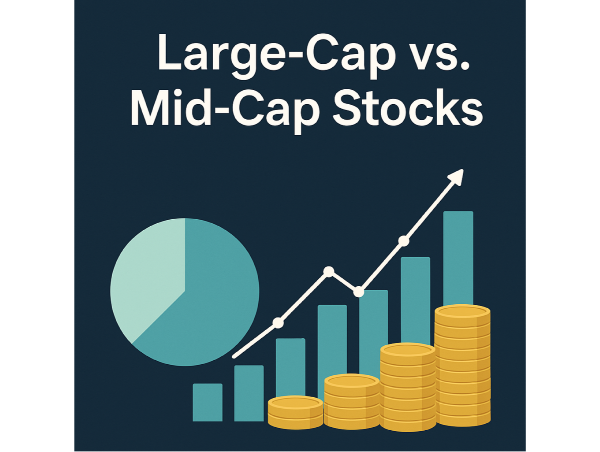Introduction
Market capitalization measures the total value of a company’s outstanding shares, providing insight into its financial strength and market position. Investors categorize stocks into different market caps—such as large-cap and mid-cap—to assess risk, growth potential, and investment suitability. Large-cap stocks, typically valued at over $10 billion, offer stability and consistent returns, making them a preferred choice for conservative investors. Mid-cap stocks, ranging from $2 billion to $10 billion, present higher growth opportunities with moderate risk, attracting those seeking a balance between security and expansion. Understanding these classifications helps investors build diversified portfolios that align with their financial goals and risk tolerance.
Understanding Large-Cap Stocks
Large-cap stocks refer to companies with a market capitalization exceeding $10 billion. These firms are often industry leaders with established business models and strong financials. Their size and market influence make them attractive to investors seeking stability and consistent returns. Large-cap stocks are commonly included in major indices such as the S&P 500 and Dow Jones Industrial Average, reinforcing their significance in the financial markets.
These companies exhibit several defining characteristics, including steady revenue streams, global brand recognition, and reliable dividend payments. Large-cap stocks tend to be less volatile than mid-cap or small-cap stocks, making them a preferred choice for conservative investors. Their ability to maintain financial strength during economic downturns further enhances their appeal. Examples of well-known large-cap stocks include Apple, Microsoft, and Johnson & Johnson, all of which have demonstrated resilience and long-term growth.
One of the key advantages of large-cap stocks is their stability in fluctuating markets. Their diversified revenue sources and strong market presence contribute to lower volatility, reducing the risk of significant losses. While they may not offer the rapid growth potential of smaller firms, their reliability makes them a cornerstone of many investment portfolios. Investors looking for steady returns and lower exposure to market swings often favor large-cap stocks.
Understanding Mid-Cap Stocks
Mid-cap stocks are companies with a market capitalization ranging from $2 billion to $10 billion. These firms occupy a middle ground between small-cap and large-cap stocks, offering investors a balance of growth potential and stability. Mid-cap stocks often represent businesses that have moved beyond the early growth phase but still have significant room for expansion. Their market capitalization is determined by multiplying the company's share price by the total number of outstanding shares, providing insight into their overall valuation.
These companies typically exhibit strong growth potential and market expansion opportunities. Many mid-cap firms operate in emerging industries or are positioned to disrupt established markets. Their ability to scale operations and introduce innovative products allows them to capture market share and drive revenue growth. Historically, mid-cap stocks have outperformed large-cap stocks during economic recoveries, as they are more agile and responsive to market trends. Investors seeking higher returns often consider mid-cap stocks for their ability to generate substantial gains while maintaining a degree of financial stability.
Mid-cap stocks present a moderate level of risk compared to small-cap and large-cap stocks. While they are generally less volatile than small-cap stocks, they still experience fluctuations due to market conditions and economic cycles. Their financial strength is typically more robust than that of small-cap companies, but they may not have the same level of resilience as large-cap firms. Investors looking for a mix of growth and stability often allocate a portion of their portfolios to mid-cap stocks, leveraging their potential for expansion while managing risk exposure.
Key Differences Between Large-Cap and Mid-Cap Stocks
Large-cap and mid-cap stocks differ in their growth potential and risk profiles. Large-cap stocks, typically valued at over $10 billion, offer stability and lower volatility, making them ideal for conservative investors. Mid-cap stocks, ranging from $2 billion to $10 billion, provide a balance between security and higher growth potential. While large-cap stocks tend to grow at a slower pace due to their market saturation, mid-cap stocks often have more room for expansion, allowing for higher returns in favorable economic conditions.
Market influence and industry positioning further distinguish these stock categories. Large-cap companies often shape global economic trends, influencing policies and market movements due to their size and financial strength. Mid-cap stocks, while not as dominant, frequently operate in emerging industries or niche markets, allowing them to capitalize on new opportunities. Investors looking for established market leaders often favor large-cap stocks, while those seeking companies with room for growth may prefer mid-cap investments. Also, liquidity and institutional investor interest also play a significant role in differentiating these stocks.
Advantages of Investing in Large-Cap Stocks
Large-cap stocks provide stability and lower volatility, making them a preferred choice for conservative investors. These companies have well-established business models, strong financials, and consistent revenue streams, allowing them to maintain steady performance even during market fluctuations. Their size and market influence reduce the likelihood of extreme price swings, offering investors a reliable option for long-term wealth preservation.
Another advantage of large-cap stocks is their ability to deliver reliable dividend payments and shareholder returns. Many large-cap companies have a history of distributing consistent dividends, providing investors with a steady income stream. Examples are Procter & Gamble and Johnson & Johnson.
Large-cap stocks also demonstrate resilience during economic downturns. Their diversified revenue streams and strong balance sheets enable them to withstand market volatility better than smaller-cap stocks. These companies often have global operations, allowing them to mitigate risks associated with regional economic fluctuations. Their ability to maintain profitability during recessions makes them a reliable investment option for those prioritizing stability in uncertain market conditions.
Advantages of Investing in Mid-Cap Stocks
Mid-cap stocks offer higher growth potential compared to large-cap stocks, making them an attractive option for investors seeking expansion opportunities. These companies, typically valued between $2 billion and $10 billion, are often in the growth phase, allowing them to scale operations and increase market share. Historically, mid-cap stocks have outperformed large-cap stocks during economic recoveries, as they are more agile and responsive to market trends. Their ability to adapt quickly to industry shifts enables them to capitalize on emerging opportunities, driving long-term value for investors.
Another advantage of mid-cap stocks is their potential for market expansion and industry disruption. Many mid-cap companies operate in innovative sectors such as technology, healthcare, and renewable energy, where they introduce groundbreaking products and services. Their ability to challenge established industry leaders allows them to carve out new market segments and gain competitive advantages. Investors looking for exposure to companies with strong growth trajectories often favor mid-cap stocks for their ability to disrupt traditional business models and create new revenue streams.
Mid-cap stocks also provide a balance between risk and reward, making them a valuable component of diversified portfolios. While they carry more risk than large-cap stocks, they are generally less volatile than small-cap stocks, offering a middle ground for investors seeking both stability and growth. Their financial strength and ability to scale operations contribute to their resilience during market fluctuations.
Potential Downsides of Large-Cap Stocks
Large-cap stocks often experience slower growth compared to mid-cap stocks due to their established market positions and maturity. These companies have already captured a significant portion of their industries, leaving limited room for expansion. Unlike mid-cap firms that can rapidly scale operations and disrupt markets, large-cap stocks tend to focus on maintaining their existing market share rather than pursuing aggressive growth strategies. This slower growth rate can make them less appealing to investors seeking high returns.
Market saturation presents another challenge for large-cap stocks. Many of these companies operate in mature industries where innovation and expansion opportunities are constrained. While they continue to generate substantial revenue, their ability to introduce groundbreaking products or services is often limited. As a result, investors may look toward mid-cap stocks for higher growth potential. Additionally, competition from emerging companies can pressure large-cap firms to adapt, sometimes leading to costly acquisitions or strategic shifts.
Large-cap stocks are also vulnerable to macroeconomic trends and global events. Inflation, interest rate fluctuations, and geopolitical instability can significantly impact their profitability. Since many large-cap companies have extensive international operations, they are exposed to economic shifts that affect multiple markets. Trade policies, currency fluctuations, and regulatory changes can influence their financial performance, making them susceptible to broader economic conditions. While their stability helps mitigate risks, external factors can still affect their long-term growth and valuation.
Potential Downsides of Mid-Cap Stocks
Mid-cap stocks tend to exhibit higher volatility and risk exposure compared to large-cap stocks. Their market positioning makes them more sensitive to economic shifts, leading to price fluctuations that can be more pronounced than those seen in larger companies. Investors seeking stability may find mid-cap stocks less predictable, as their valuations can be influenced by industry trends, investor sentiment, and broader market conditions. While their growth potential is attractive, the increased volatility requires careful risk management.
Another downside of mid-cap stocks is their relatively lower financial stability compared to large-cap companies. Mid-cap firms often have fewer financial resources, making them more vulnerable to economic downturns or unexpected market disruptions. Unlike large-cap stocks, which typically have diversified revenue streams and strong balance sheets, mid-cap companies may struggle with liquidity and access to capital. This limitation can affect their ability to invest in expansion, innovation, or withstand prolonged periods of economic uncertainty.
Mid-cap stocks are also more susceptible to economic downturns and market fluctuations. During recessions or periods of financial instability, mid-cap companies may experience sharper declines in stock value compared to their large-cap counterparts. Their reliance on growth strategies and market expansion makes them more exposed to shifts in consumer demand and industry-specific challenges. Investors considering mid-cap stocks should assess their risk tolerance and ensure proper diversification to mitigate potential losses during volatile market conditions.
How Large-Cap and Mid-Cap Stocks Fit Into an Investment Portfolio
Large-cap and mid-cap stocks play distinct roles in portfolio diversification, helping investors manage risk while optimizing returns. Diversification involves spreading investments across different asset classes and market capitalizations to reduce exposure to volatility. Large-cap stocks provide stability and consistent returns, while mid-cap stocks offer higher growth potential with moderate risk. A well-balanced portfolio incorporates both categories to achieve a mix of security and expansion opportunities.
Balancing large-cap and mid-cap investments allows investors to tailor their portfolios based on financial goals and risk tolerance. Large-cap stocks serve as a foundation of reliability, offering steady performance and dividend income. Mid-cap stocks, on the other hand, provide opportunities for market expansion and industry disruption, making them attractive to investors seeking growth. Allocating investments strategically between these categories ensures exposure to different market dynamics, reducing overall portfolio risk.
Investment strategies should consider time horizons. Long-term investors benefit from the stability and dividend income of large-cap stocks, making them ideal for retirement portfolios. Short-term investors may find mid-cap stocks more appealing due to their potential for rapid appreciation.
Historical Performance Comparisons
Large-cap and mid-cap stocks have demonstrated distinct performance trends over time, influenced by market conditions and economic cycles. Historically, mid-cap stocks have often outperformed large-cap stocks during periods of economic expansion, as they have more room for growth and can capitalize on emerging opportunities.
Large-cap stocks, on the other hand, tend to provide more stable returns, particularly during market downturns, due to their established market positions and diversified revenue streams. Investors analyzing historical data often find that mid-cap stocks offer higher returns but come with increased volatility compared to large-cap stocks.
Economic cycles play a crucial role in shaping the performance of large-cap and mid-cap stocks. During periods of economic growth, mid-cap stocks tend to thrive as businesses expand and consumer demand increases. Conversely, during recessions or financial crises, large-cap stocks often demonstrate resilience, as their financial stability and market dominance allow them to weather downturns more effectively. Understanding these cycles helps investors determine the right allocation between large-cap and mid-cap stocks based on their risk tolerance and investment horizon.
Several case studies highlight successful investments in both categories. Companies like Microsoft and Apple, which started as mid-cap stocks, transitioned into large-cap status due to sustained growth and market leadership. Similarly, mid-cap firms such as Shopify and Zoom have demonstrated rapid expansion, attracting investor interest.
Large-cap stocks like Johnson & Johnson and Berkshire Hathaway have maintained steady returns over decades, reinforcing their role as reliable investments. Examining these success stories provides valuable insights into how companies evolve and perform across different market capitalizations.
Is It Better to Invest in Large-Cap or Mid-Cap Stocks?
Investors deciding between large-cap and mid-cap stocks must consider several factors, including growth potential, risk exposure, and market conditions. Large-cap stocks, typically valued at over $10 billion, offer stability and lower volatility, making them ideal for conservative investors. Mid-cap stocks, ranging from $2 billion to $10 billion, provide higher growth opportunities but come with increased risk. Understanding these differences helps investors align their choices with their financial objectives and market outlook.
Risk tolerance plays a crucial role in determining the right investment strategy. Investors with a higher risk appetite may prefer mid-cap stocks due to their potential for rapid appreciation. However, these stocks are more susceptible to market fluctuations and economic downturns. Large-cap stocks, with their established market positions and strong financials, offer lower risk and steady returns, making them a safer option for those prioritizing capital preservation. Balancing risk and reward is essential when constructing a portfolio that meets individual financial goals.
Portfolio allocation strategies vary based on investor preferences and market conditions. A diversified portfolio often includes a mix of large-cap and mid-cap stocks to optimize growth while managing risk. Investors seeking aggressive expansion may allocate a higher percentage to mid-cap stocks, while those prioritizing stability may favor large-cap holdings. Understanding market cycles and economic trends helps investors make informed decisions about portfolio composition, ensuring long-term financial success.
Conclusion
Mega-cap stocks play a vital role in the investment landscape, offering stability, consistent returns, and industry leadership. Their ability to withstand economic downturns and maintain steady growth makes them an essential component of long-term investment portfolios. While they may not provide the rapid appreciation seen in smaller-cap stocks, their reliability and financial strength make them attractive to conservative investors.
Understanding the advantages and limitations of mega-cap stocks allows investors to make informed decisions when structuring their portfolios. A balanced investment approach that includes a mix of market capitalizations can help mitigate risk while optimizing growth, ensuring a well-diversified strategy that aligns with financial goals and market conditions.






























Introduction
Market capitalization measures the total value of a company’s outstanding shares, providing insight into its financial strength and market position. Investors categorize stocks into different market caps—such as large-cap and mid-cap—to assess risk, growth potential, and investment suitability. Large-cap stocks, typically valued at over $10 billion, offer stability and consistent returns, making them a preferred choice for conservative investors. Mid-cap stocks, ranging from $2 billion to $10 billion, present higher growth opportunities with moderate risk, attracting those seeking a balance between security and expansion. Understanding these classifications helps investors build diversified portfolios that align with their financial goals and risk tolerance.
Understanding Large-Cap Stocks
Large-cap stocks refer to companies with a market capitalization exceeding $10 billion. These firms are often industry leaders with established business models and strong financials. Their size and market influence make them attractive to investors seeking stability and consistent returns. Large-cap stocks are commonly included in major indices such as the S&P 500 and Dow Jones Industrial Average, reinforcing their significance in the financial markets.
These companies exhibit several defining characteristics, including steady revenue streams, global brand recognition, and reliable dividend payments. Large-cap stocks tend to be less volatile than mid-cap or small-cap stocks, making them a preferred choice for conservative investors. Their ability to maintain financial strength during economic downturns further enhances their appeal. Examples of well-known large-cap stocks include Apple, Microsoft, and Johnson & Johnson, all of which have demonstrated resilience and long-term growth.
One of the key advantages of large-cap stocks is their stability in fluctuating markets. Their diversified revenue sources and strong market presence contribute to lower volatility, reducing the risk of significant losses. While they may not offer the rapid growth potential of smaller firms, their reliability makes them a cornerstone of many investment portfolios. Investors looking for steady returns and lower exposure to market swings often favor large-cap stocks.
Understanding Mid-Cap Stocks
Mid-cap stocks are companies with a market capitalization ranging from $2 billion to $10 billion. These firms occupy a middle ground between small-cap and large-cap stocks, offering investors a balance of growth potential and stability. Mid-cap stocks often represent businesses that have moved beyond the early growth phase but still have significant room for expansion. Their market capitalization is determined by multiplying the company's share price by the total number of outstanding shares, providing insight into their overall valuation.
These companies typically exhibit strong growth potential and market expansion opportunities. Many mid-cap firms operate in emerging industries or are positioned to disrupt established markets. Their ability to scale operations and introduce innovative products allows them to capture market share and drive revenue growth. Historically, mid-cap stocks have outperformed large-cap stocks during economic recoveries, as they are more agile and responsive to market trends. Investors seeking higher returns often consider mid-cap stocks for their ability to generate substantial gains while maintaining a degree of financial stability.
Mid-cap stocks present a moderate level of risk compared to small-cap and large-cap stocks. While they are generally less volatile than small-cap stocks, they still experience fluctuations due to market conditions and economic cycles. Their financial strength is typically more robust than that of small-cap companies, but they may not have the same level of resilience as large-cap firms. Investors looking for a mix of growth and stability often allocate a portion of their portfolios to mid-cap stocks, leveraging their potential for expansion while managing risk exposure.
Key Differences Between Large-Cap and Mid-Cap Stocks
Large-cap and mid-cap stocks differ in their growth potential and risk profiles. Large-cap stocks, typically valued at over $10 billion, offer stability and lower volatility, making them ideal for conservative investors. Mid-cap stocks, ranging from $2 billion to $10 billion, provide a balance between security and higher growth potential. While large-cap stocks tend to grow at a slower pace due to their market saturation, mid-cap stocks often have more room for expansion, allowing for higher returns in favorable economic conditions.
Market influence and industry positioning further distinguish these stock categories. Large-cap companies often shape global economic trends, influencing policies and market movements due to their size and financial strength. Mid-cap stocks, while not as dominant, frequently operate in emerging industries or niche markets, allowing them to capitalize on new opportunities. Investors looking for established market leaders often favor large-cap stocks, while those seeking companies with room for growth may prefer mid-cap investments. Also, liquidity and institutional investor interest also play a significant role in differentiating these stocks.
Advantages of Investing in Large-Cap Stocks
Large-cap stocks provide stability and lower volatility, making them a preferred choice for conservative investors. These companies have well-established business models, strong financials, and consistent revenue streams, allowing them to maintain steady performance even during market fluctuations. Their size and market influence reduce the likelihood of extreme price swings, offering investors a reliable option for long-term wealth preservation.
Another advantage of large-cap stocks is their ability to deliver reliable dividend payments and shareholder returns. Many large-cap companies have a history of distributing consistent dividends, providing investors with a steady income stream. Examples are Procter & Gamble and Johnson & Johnson.
Large-cap stocks also demonstrate resilience during economic downturns. Their diversified revenue streams and strong balance sheets enable them to withstand market volatility better than smaller-cap stocks. These companies often have global operations, allowing them to mitigate risks associated with regional economic fluctuations. Their ability to maintain profitability during recessions makes them a reliable investment option for those prioritizing stability in uncertain market conditions.
Advantages of Investing in Mid-Cap Stocks
Mid-cap stocks offer higher growth potential compared to large-cap stocks, making them an attractive option for investors seeking expansion opportunities. These companies, typically valued between $2 billion and $10 billion, are often in the growth phase, allowing them to scale operations and increase market share. Historically, mid-cap stocks have outperformed large-cap stocks during economic recoveries, as they are more agile and responsive to market trends. Their ability to adapt quickly to industry shifts enables them to capitalize on emerging opportunities, driving long-term value for investors.
Another advantage of mid-cap stocks is their potential for market expansion and industry disruption. Many mid-cap companies operate in innovative sectors such as technology, healthcare, and renewable energy, where they introduce groundbreaking products and services. Their ability to challenge established industry leaders allows them to carve out new market segments and gain competitive advantages. Investors looking for exposure to companies with strong growth trajectories often favor mid-cap stocks for their ability to disrupt traditional business models and create new revenue streams.
Mid-cap stocks also provide a balance between risk and reward, making them a valuable component of diversified portfolios. While they carry more risk than large-cap stocks, they are generally less volatile than small-cap stocks, offering a middle ground for investors seeking both stability and growth. Their financial strength and ability to scale operations contribute to their resilience during market fluctuations.
Potential Downsides of Large-Cap Stocks
Large-cap stocks often experience slower growth compared to mid-cap stocks due to their established market positions and maturity. These companies have already captured a significant portion of their industries, leaving limited room for expansion. Unlike mid-cap firms that can rapidly scale operations and disrupt markets, large-cap stocks tend to focus on maintaining their existing market share rather than pursuing aggressive growth strategies. This slower growth rate can make them less appealing to investors seeking high returns.
Market saturation presents another challenge for large-cap stocks. Many of these companies operate in mature industries where innovation and expansion opportunities are constrained. While they continue to generate substantial revenue, their ability to introduce groundbreaking products or services is often limited. As a result, investors may look toward mid-cap stocks for higher growth potential. Additionally, competition from emerging companies can pressure large-cap firms to adapt, sometimes leading to costly acquisitions or strategic shifts.
Large-cap stocks are also vulnerable to macroeconomic trends and global events. Inflation, interest rate fluctuations, and geopolitical instability can significantly impact their profitability. Since many large-cap companies have extensive international operations, they are exposed to economic shifts that affect multiple markets. Trade policies, currency fluctuations, and regulatory changes can influence their financial performance, making them susceptible to broader economic conditions. While their stability helps mitigate risks, external factors can still affect their long-term growth and valuation.
Potential Downsides of Mid-Cap Stocks
Mid-cap stocks tend to exhibit higher volatility and risk exposure compared to large-cap stocks. Their market positioning makes them more sensitive to economic shifts, leading to price fluctuations that can be more pronounced than those seen in larger companies. Investors seeking stability may find mid-cap stocks less predictable, as their valuations can be influenced by industry trends, investor sentiment, and broader market conditions. While their growth potential is attractive, the increased volatility requires careful risk management.
Another downside of mid-cap stocks is their relatively lower financial stability compared to large-cap companies. Mid-cap firms often have fewer financial resources, making them more vulnerable to economic downturns or unexpected market disruptions. Unlike large-cap stocks, which typically have diversified revenue streams and strong balance sheets, mid-cap companies may struggle with liquidity and access to capital. This limitation can affect their ability to invest in expansion, innovation, or withstand prolonged periods of economic uncertainty.
Mid-cap stocks are also more susceptible to economic downturns and market fluctuations. During recessions or periods of financial instability, mid-cap companies may experience sharper declines in stock value compared to their large-cap counterparts. Their reliance on growth strategies and market expansion makes them more exposed to shifts in consumer demand and industry-specific challenges. Investors considering mid-cap stocks should assess their risk tolerance and ensure proper diversification to mitigate potential losses during volatile market conditions.
How Large-Cap and Mid-Cap Stocks Fit Into an Investment Portfolio
Large-cap and mid-cap stocks play distinct roles in portfolio diversification, helping investors manage risk while optimizing returns. Diversification involves spreading investments across different asset classes and market capitalizations to reduce exposure to volatility. Large-cap stocks provide stability and consistent returns, while mid-cap stocks offer higher growth potential with moderate risk. A well-balanced portfolio incorporates both categories to achieve a mix of security and expansion opportunities.
Balancing large-cap and mid-cap investments allows investors to tailor their portfolios based on financial goals and risk tolerance. Large-cap stocks serve as a foundation of reliability, offering steady performance and dividend income. Mid-cap stocks, on the other hand, provide opportunities for market expansion and industry disruption, making them attractive to investors seeking growth. Allocating investments strategically between these categories ensures exposure to different market dynamics, reducing overall portfolio risk.
Investment strategies should consider time horizons. Long-term investors benefit from the stability and dividend income of large-cap stocks, making them ideal for retirement portfolios. Short-term investors may find mid-cap stocks more appealing due to their potential for rapid appreciation.
Historical Performance Comparisons
Large-cap and mid-cap stocks have demonstrated distinct performance trends over time, influenced by market conditions and economic cycles. Historically, mid-cap stocks have often outperformed large-cap stocks during periods of economic expansion, as they have more room for growth and can capitalize on emerging opportunities.
Large-cap stocks, on the other hand, tend to provide more stable returns, particularly during market downturns, due to their established market positions and diversified revenue streams. Investors analyzing historical data often find that mid-cap stocks offer higher returns but come with increased volatility compared to large-cap stocks.
Economic cycles play a crucial role in shaping the performance of large-cap and mid-cap stocks. During periods of economic growth, mid-cap stocks tend to thrive as businesses expand and consumer demand increases. Conversely, during recessions or financial crises, large-cap stocks often demonstrate resilience, as their financial stability and market dominance allow them to weather downturns more effectively. Understanding these cycles helps investors determine the right allocation between large-cap and mid-cap stocks based on their risk tolerance and investment horizon.
Several case studies highlight successful investments in both categories. Companies like Microsoft and Apple, which started as mid-cap stocks, transitioned into large-cap status due to sustained growth and market leadership. Similarly, mid-cap firms such as Shopify and Zoom have demonstrated rapid expansion, attracting investor interest.
Large-cap stocks like Johnson & Johnson and Berkshire Hathaway have maintained steady returns over decades, reinforcing their role as reliable investments. Examining these success stories provides valuable insights into how companies evolve and perform across different market capitalizations.
Is It Better to Invest in Large-Cap or Mid-Cap Stocks?
Investors deciding between large-cap and mid-cap stocks must consider several factors, including growth potential, risk exposure, and market conditions. Large-cap stocks, typically valued at over $10 billion, offer stability and lower volatility, making them ideal for conservative investors. Mid-cap stocks, ranging from $2 billion to $10 billion, provide higher growth opportunities but come with increased risk. Understanding these differences helps investors align their choices with their financial objectives and market outlook.
Risk tolerance plays a crucial role in determining the right investment strategy. Investors with a higher risk appetite may prefer mid-cap stocks due to their potential for rapid appreciation. However, these stocks are more susceptible to market fluctuations and economic downturns. Large-cap stocks, with their established market positions and strong financials, offer lower risk and steady returns, making them a safer option for those prioritizing capital preservation. Balancing risk and reward is essential when constructing a portfolio that meets individual financial goals.
Portfolio allocation strategies vary based on investor preferences and market conditions. A diversified portfolio often includes a mix of large-cap and mid-cap stocks to optimize growth while managing risk. Investors seeking aggressive expansion may allocate a higher percentage to mid-cap stocks, while those prioritizing stability may favor large-cap holdings. Understanding market cycles and economic trends helps investors make informed decisions about portfolio composition, ensuring long-term financial success.
Conclusion
Mega-cap stocks play a vital role in the investment landscape, offering stability, consistent returns, and industry leadership. Their ability to withstand economic downturns and maintain steady growth makes them an essential component of long-term investment portfolios. While they may not provide the rapid appreciation seen in smaller-cap stocks, their reliability and financial strength make them attractive to conservative investors.
Understanding the advantages and limitations of mega-cap stocks allows investors to make informed decisions when structuring their portfolios. A balanced investment approach that includes a mix of market capitalizations can help mitigate risk while optimizing growth, ensuring a well-diversified strategy that aligns with financial goals and market conditions.